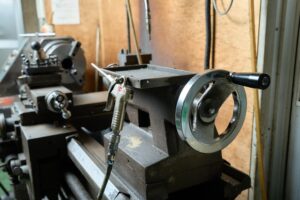Intro
When you want to fabricate a part, you’ll have to start by finding the best machine shop that can handle your request. This largely revolves around the company’s capabilities and what machines they have on the floor. In order to find the best machine shop, you’ll need to know the difference between a lathe and a turning center.
In this expert guide, our professional machinists will teach you the difference between these two machines, and we’ll help you understand which option is right for your project.
What Is a Lathe?
A traditional lathe is a 2 or 3-axis machine that holds material rigidly on one end, while a turning blade is moved on the other end. The two ends share a common axis, and the second axis allows the part or blade to move towards or away from the centerline of the first axis.
In simpler terms, a lathe can move in the Y direction and the Z direction. Since the tool is spinning concentrically around the Y axis, a 2-axis lathe doesn’t have a need to change in the X direction. A 3-axis lathe simply gives more control over the machine, which is especially helpful for making more complicated parts.
Most modern lathes are CNC-operating, meaning that there is a level of automation and precision that you don’t get with manual lathes.

What Is a Turning Center?
Turning centers can look a lot like a lathe to an untrained eye. In fact, there’s no rigid definition that will explain clearly which machine is considered a lathe, and which is considered a turning center.
In our experience, a turning center is a higher-tech version of a lathe, offering more functionality and usability. Turning centers are available as 3-axis, 4-axis, and 5-axis machines, with 3-axis turning centers falling into a bit of a gray area.
Regardless, these multi-axial turning centers allow you to do much more than just drill holes and make concentric patterns. With the additional axes, a machinist can do more cuts with a single material setup.
Most turning centers also have the ability to change tool bits without any human interactions, which is called “live tooling”. The center can change from a cutting bit to a drilling bit automatically, then it can start the next operation.
This allows turning centers to accomplish a lot more in a shorter period of time.
Major Differences Between a Lathe and a Turning Center
We explained that turning centers are much more advanced and have more functionality over traditional lathes, but what are the specific differences? As a customer, consider the following differences before choosing which machine should make your part.
Machine Versatility
A turning machine is significantly more versatile than a traditional lathe. With a lathe, you might only be able to cut holes and shape your parts. With a turning machine, you can achieve turning, facing, threading, knurling, drilling, boring, reaming, and tapering.
Part Complexity
To put it simply, a turning center can make more complicated parts than a CNC lathe can. This is due to a combination of the added versatility and extra axes.
If you just want a simple part, you can choose either a lathe or turning center. For complicated parts, you’ll want to stick with turning centers.
Total Efficiency
A turning center can do a lot more in less time than a lathe can. As a result, it’s a much more efficient machine to have within a manufacturing center.
Cost and Operational Costs
The upfront cost of buying a CNC lathe can be one-quarter of the cost of buying a CNC turning machine. However, the operating costs are typically similar, if not a little lower for turning centers. This cost savings is largely due to the added automation and lack of machinist supervision required for turning centers.
However, a machine shop can easily charge more for their turning center projects in an effort to make up for the larger upfront costs and as compensation for the added precision that turning centers achieve.
Part Turnaround Times
Speaking generally, you’ll usually see faster part turnaround times with turning machines as compared to lathes. While an experienced machinist can still commit to aggressive turnaround times on a lathe, the added efficiency, speed, and axes of a turning center result in faster parts.
Conclusion
As you just learned, there’s a lot of overlap between lathes and turning centers. However, a turning center takes a lathe into the 21st century with its additional axes and added “live tooling” functionality. Turning centers are faster, more efficient, and a more streamlined way to make parts.
For high-quality parts with fast turnarounds, consider Rapid Axis. Our machinists can use lathes or turning centers to create high-quality parts for your company. Get a free quote today to get started.
